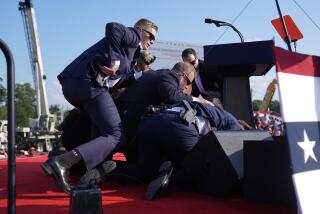Welcome mat’s out, with a little red tape
- Share via
During a recent visit to Washington, D.C., I enjoyed a privilege that Americans may incorrectly assume is no longer available.
I visited the White House.
Since Sept. 11, 2001, the kind of impromptu sightseeing decision that tourists used to make -- you simply stood in line at a White House gate -- has been impossible for security reasons.
Visits per se are not impossible, but they do require planning. In my case, the organizers of the event I attended made arrangements for a small group to be admitted to the building’s ground and state floors.
Individuals can also arrange such a visit by contacting their congressional representative about six months before they plan to be in the capital.
Although White House visits currently are permitted only for organized groups of at least 10 people, any of your representatives can arrange for you to be added to an existing group.
After the date and time of your visit has been confirmed by your member of Congress, you’ll be asked to provide the name, date of birth and Social Security number for each member of your party.
Next, you’ll be advised to appear at a particular White House gate; adults must come with photo ID. And your name will then be checked against an approved list of visitors for that day.
The experience is well worth the effort. The White House remains a remarkable repository of history and current-day importance.
Its interior is often reminiscent of a European palace: lined with marble, covered with priceless rugs and oil paintings, furnished with stunning antiques and dotted with precious artifacts left by previous inhabitants.
All of it is preceded by entrance corridors decorated with candid photographs of re- cent presidents interacting with their families or political associates.
Every 10 yards or so, as you move along, is a courteous Secret Service officer or other uniformed official; the degree of security is awesome. Though their function is to protect residents and staff, they are willing to assist visitors with information.
One of them might point out how an early depiction of the White House was discovered in an auction of cheap paintings in Baltimore and is today valued in the millions. Another might tell you how young children of a president played in the very room you are touring.
Though some of the rugs in reception rooms are rolled back to permit the easy passage of tourists (there were at least three other groups, including schoolchildren from Atlanta, at the time of my visit), these rooms are used for current ceremonial occasions. Their rugs are rolled back into place as soon as visiting hours are over, the public departs and the diplomatic guests arrive.
Every president other than George Washington has lived in this structure (though burned by the British in 1814, it was later restored) and dined in it.
Some have had weddings of their children there or have lain in state. Thomas Jefferson held the first open house. For the most part, tourists have been able to visit it without difficulty through the years.
For more information (or to take a video tour), see www.whitehouse.gov.
At the end of your visit, if you’re seeking a drink or a meal, head up to 675 15th St. N.W. (between F and G streets), where the Old Ebbitt Grill has been in continuous operation since 1856, serving presidents, Washington insiders and tourists.
Its rich, clubby atmosphere offers an interesting stop for adults or kids. And its big, excellent hamburgers (served with a fruit cocktail or fries) cost only about $7.50.
More to Read
Sign up for The Wild
We’ll help you find the best places to hike, bike and run, as well as the perfect silent spots for meditation and yoga.
You may occasionally receive promotional content from the Los Angeles Times.






